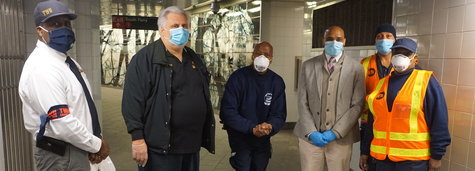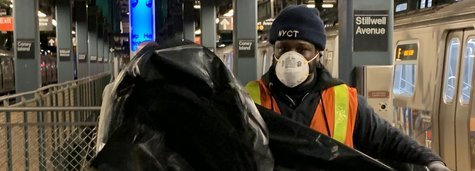MTA Compelled to Make Track Safety Rule Changes
Under intense union pressure, the MTA has been compelled to make unprecedented track-safety rule changes to prevent another tragedy like the line-of- duty death of subway Construction Flagger Louis Gray Jr. on Nov. 3, 2016.
Gray was on a curved track setting up yellow warning lights for a construction project that was about to get underway when a G train came around the bend and struck him. Gray’s co-workers, Jeffrey Fleming, was seriously injured but survived. The tragedy exposed serious, life-threatening flaws in the MTA’s safety protocols. The G-train operator had no idea that Gray and Fleming were up ahead when he left the nearest station. He couldn’t stop in time when he came upon the two men on the tracks between Fort Hamilton Parkway and Church Avenue stations.
The MTA balked at TWU’s demands for new safety measures, so the union forced the dispute into emergency arbitration. The MTA has now agreed to suspend train traffic when flaggers are setting yellow warning lights out in advance of a construction project on curves with limited visibility and other extremely dangerous areas. (sections of track where there are no safety niches for a transit worker to quickly find refuge should a train be coming) “This is a big win for the safety of New York City transit workers,” Local 100 President John Samuelsen said. “Past efforts to get the company to even slow the trains down were extremely difficult. Now, the trains must not only slow down but completely suspend service and this is unprecedented.” Flagging lights are set up to warn approaching trains that workers may be on the tracks ahead and to proceed with extreme caution.
After Gray’s death, the MTA issued a bulletin with regulation changes that were too weak and amounted to nothing more than “nibbling around the edges,” Samuelsen said. Local 100 took the matter to emergency arbitration. After an all-day hearing on Friday Dec. 2nd, both sides, along with the arbitrator, signed a legal document adopting the new protocols halting trains in certain circumstances. “It’s a travesty that another transit worker lost his life on the job,” Samuelsen said. It’s also a travesty that this matter had to go to arbitration. The MTA should have done the right thing in the immediate aftermath of this tragedy.” The NTSB, which is investigating the accident, approved of the new protocols Tuesday. The MTA has scheduled a 24-hour “safety stand down” starting at 10 p.m. Wednesday, December 7th. During that time, all non-emergency track work will be suspended so workers can be educated on the new regulations.













